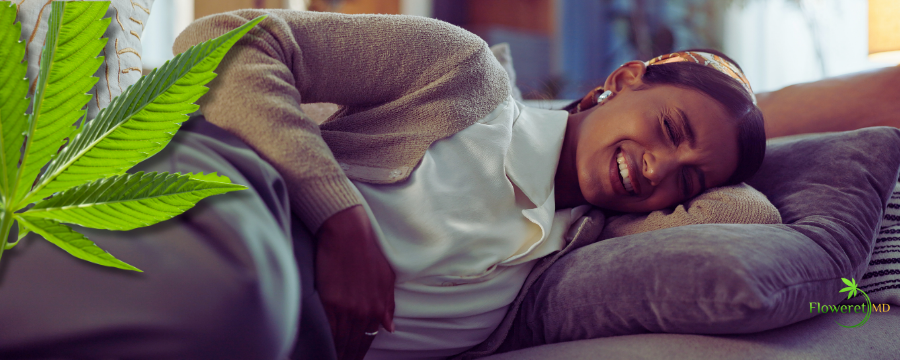- Texas Medical Cannabis Dispensaries vs Hemp Stores
- 5 Easy Steps to Fill Your Prescription
- Decoding Texas Cannabis Ratios: 20:1, 1:1, 0:1…
- Dosing & Product Education
- Texas CUP News & Legislation
- Conditions & Symptom Relief
- Practice Updates & Patient Stories
- Caregivers & Family Support
- Compliance & Legal FAQs
- Texas Medical Cannabis Guidebook 📚
- Complete Learning Library 📚
Managing Endometriosis Pain with Low-THC Cannabis: A Women’s Health Spotlight

Managing Endometriosis Pain with Low-THC Cannabis: A Women’s Health Spotlight
👀 Endometriosis Isn’t Just “Bad Cramps”
Endometriosis affects approximately 1 in 10 women of reproductive age, yet it remains one of the most underdiagnosed and misunderstood conditions. This chronic disorder occurs when tissue similar to the lining of the uterus grows outside of it, causing inflammation, internal scarring, and sometimes debilitating pain.
Common symptoms include:
-
Severe pelvic pain (especially during menstruation)
-
Lower back and leg pain
-
Pain during sex or bowel movements
-
Fatigue, nausea, and bloating
-
Difficulty conceiving
For many women, the condition isn’t just disruptive during their period—it impacts their everyday quality of life, relationships, work performance, and emotional wellbeing.
Conventional treatments like hormonal birth control, laparoscopic surgery, and NSAIDs don’t always bring relief—or they come with side effects some women aren’t willing to tolerate long term.
💡 Why Medical Cannabis May Offer a More Holistic Option
In recent years, low-THC medical cannabis has emerged as a promising support option for endometriosis management. Why? Because the endocannabinoid system (ECS)—which helps regulate pain, inflammation, and hormone balance—plays an active role in female reproductive health.
Cannabinoids like CBD (cannabidiol) and THC (tetrahydrocannabinol) interact with receptors found throughout the uterus, ovaries, and pelvic region. In studies and anecdotal reports, they’ve been shown to:
-
Reduce pelvic and abdominal pain
-
Calm inflammation around endometrial tissue
-
Ease muscle spasms and cramping
-
Improve sleep and emotional stability during flare-ups
For Texas patients eligible under the Compassionate Use Program (CUP), formulations like 4:1 CBD:THC or 1:1 CBD:THC tinctures and capsules allow for daytime functionality with balanced relief.
✅ What Real Women Report After Adding Low-THC
Patients using medical cannabis for endometriosis symptoms in Texas have reported:
| Reported Benefit | Patient Experience |
|---|---|
| 🌿 Decreased daily pain | “I’m able to cook, clean, and work on my feet without doubling over.” |
| 😴 Better sleep | “I’m no longer waking up at 2 AM from stabbing pain.” |
| 💊 Fewer NSAIDs and pain meds | “I cut my ibuprofen in half—and no longer feel like I’m living on heating pads.” |
| 🧘 More emotional resilience | “I don’t feel as anxious or hopeless when flare-ups hit.” |
| 📅 Fewer missed work days | “I finally feel like I can plan my life around more than just my symptoms.” |
Of course, every body is different. What works for one patient may need to be adjusted for another. But one thing is consistent: patients feel empowered by having another option that works with their body instead of against it.
🎯 Your Personalized Plan Starts Here
If you’re living with endometriosis in Texas, you may qualify for medical cannabis under CUP. Here’s how Floweret MD can help:
1. Book a Compassionate Telehealth Visit
You’ll meet with a physician experienced in women’s health and cannabis-based treatment. No awkward in-office waits—just a judgment-free video call from the comfort of home.
2. Discuss Your Symptoms and Goals
Bring a symptom journal, pain tracker, or period app if you use one. Let us know what’s working, what’s not, and what you’re hoping to achieve—whether it’s pain relief, fewer flare-ups, or better rest.
 3. Explore the Right Ratios
3. Explore the Right Ratios
Common ratios for endometriosis include:
-
4:1 CBD:THC – gentle for daytime use
-
1:1 CBD:THC – stronger relief for evenings
-
Topical balms for lower back or pelvic pain
We’ll help you find the right strength and schedule based on your cycle and sensitivity.
4. Monitor & Adjust
Every patient journey is unique. We’ll check in, help you adjust, and fine-tune your treatment based on results.
✨ Final Thought
Living with endometriosis doesn’t have to mean suffering in silence. Low-THC medical cannabis isn’t a cure—but for many Texas women, it’s a powerful tool for regaining comfort, mobility, and control.
💬 Ready to Take the Next Step?
📌 Book your telehealth appointment at floweretmd.com
🧡 Compassionate care. Clear guidance. No unnecessary barriers.
This content is educational and not medical advice. Consult a qualified healthcare professional before starting, changing, or stopping any cannabis or other treatment.
📚 References
-
National Institute of Child Health and Human Development. Endometriosis: Overview.
https://www.nichd.nih.gov/health/topics/endometriosis -
Sinaii N, Cleary SD, Ballweg ML, et al. High rates of symptom onset and diagnosis delay in women with endometriosis. J Obstet Gynaecol Res. 2002.
-
McHugh T, et al. Role of cannabinoids in pain modulation related to endometriosis. International Journal of Molecular Sciences. 2020.
-
Texas Department of Public Safety – Compassionate Use Program.
https://www.dps.texas.gov/section/compassionate-use-program


